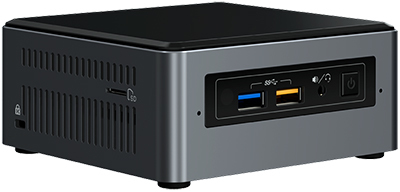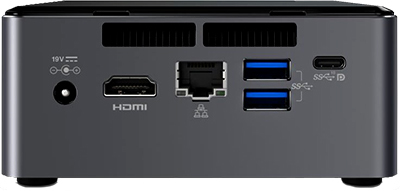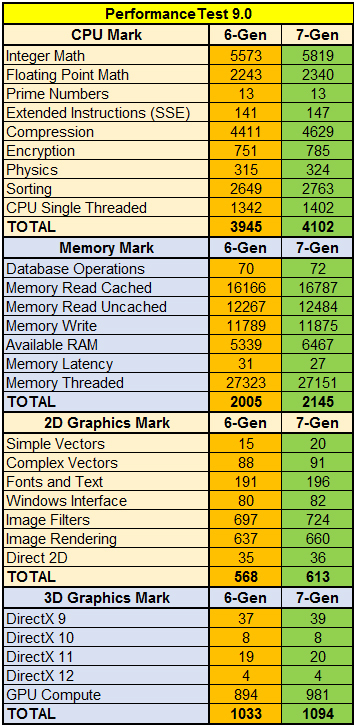New Intel NUC 7th Generation - Review, Comparison, Testing
 Compact mini-PCs based on Intel NUC have recently found widespread use in various IT areas. High-powered Intel Core i3 / i5 / i7 processors in combination with a miniature form factor allow you to use such devices as a home or office computer, a client terminal, or a specialized multimedia device. For example, our company based on Intel NUC has built a line of software conferencing terminals for video conferencing . We talked about the use of these terminals in the article " Equipment for videoconferencing for meeting rooms ."
Compact mini-PCs based on Intel NUC have recently found widespread use in various IT areas. High-powered Intel Core i3 / i5 / i7 processors in combination with a miniature form factor allow you to use such devices as a home or office computer, a client terminal, or a specialized multimedia device. For example, our company based on Intel NUC has built a line of software conferencing terminals for video conferencing . We talked about the use of these terminals in the article " Equipment for videoconferencing for meeting rooms ."And now a new line of mini-devices based on mobile 7th generation Intel Core processors has appeared. The price is similar to the 6th generation, the characteristics at first glance are almost identical.
In order to understand the distinctive features and advantages of the new platform, a number of type tests were carried out, the results of which are given under the cut.
Overview
For the review was chosen younger model NUC7i3BNH based on Intel Core i3-7100U.
There are 2 form factors for i3 / i5 platforms:
- a very thin case without a 2.5 "bays for HDD or SSD (with the letter" K "at the end of the kit name);

- and, as in our case, the model with the installed M.2 SSD 128Gb + 2.5 "HDD 1Tb (with the letter“ H ”at the end of the kit name) is 16 mm higher.
')

Comparison of kits on the Intel site, which shows that there are no other differences.
The differences in design from the sixth generation NUC are noticeable immediately - the power button is transferred from the top cover to the front panel (probably to make it easier to put the NUC-on each other), the disk activity indicator turned into a thin frame around the front panel connectors, a full-size slot for The SD card on the side was replaced with an option for a smaller microSD size.

The rear panel has also undergone changes. There was a 10Gbps USB 3.1 Gen 2 connector (also known as USB Type-C, also known as USB-C), which can be used as a Mini DisplayPort 1.2. The power connector of the new platform is now on the same line and too close to HDMI, which causes considerable difficulties when connecting the video cable via a DVI-HDMI adapter.
For access inside, installation of the RAM and drives, Intel NUC case understands from below. In our case, in this model, behind the bottom cover is a basket with a 2.5 "Seagate Barracuda hard drive installed in 1Tb.


The platform supports the installation of two DDR4 SO-DIMM memory modules and one M.2 SSD-drive, there is also an internal 2 x USB 2.0 connector. In addition to all this, there are no other internal free connectors in this model.
The package includes a VESA mount that allows you to attach the NUC to the back of the monitor or mount it on the wall.
Comparison, testing
The seventh generation of Intel NUC did not bring anything fundamentally new. From the comparative table of Intel Core i3-6100U and i3-7100U processors , highlighting the differences, it is clear that the main changes were: the new graphics core and the increased (by 0.1 GHz) clock frequency.
To compare the performance of the "new" and "old" systems, we tested two similar configurations of the 6th and 7th generations of the Intel NUC in the available common benchmarks.

Comprehensive benchmark PerformanceTest 9.0 showed a stable insignificant advantage of the new generation. But, given the frequency of the processor increased by 100 MHz, this is understandable - if you divide the results by the frequency, you get almost the same values in the processor and memory tests. But in the graphics performance tests, the results were slightly higher, even considering the frequency.
Since many people use NUC as a home PC, and often even play on it, the results of the 3DMARK gaming graphics benchmark will be in place.

In 3DMARK there are several different tests for systems of different performance - from mobile devices to gaming PCs with two top-end video cards. It seemed reasonable to drive off only the middle options, i.e., all but the first and last.
The advantage of Intel HD Graphics 620 over 520 in tests for entry-level PCs is quite significant. But, as the load increases, the advantage gradually decreases. In any case, the performance of integrated graphics, IMHO, has achieved significant results today, which allows using mini-PCs for most tasks, including those related to video or graphics.
Also, for the sake of interest, testing was conducted at CINEBENCH and 7ZIP.


In these tests, the performance gain of the new generation platform is so insignificant that when translating the results into the parrot-to-gigahertz ratio, you can even see a slight drop in Intel NUC 7-Gen against 6-Gen.
findings
In fact, the advantages of the architecture of Kaby Lake before Skylake were not found - we will wait for the change in process technology, there may be advantages. Perhaps, in order to show at least some performance increase, this 1/10 gigahertz was added to the processor frequency.
A comparison of Intel HD Graphics 620 vs. Intel HD Graphics 520 also revealed a not very tangible advantage.
On this basis, intentionally changing the 6th generation of the NUC to the 7th, apparently, there is little sense.
But if you have to buy a new PC - then, of course, it is better to prefer a more recent model. In addition, it costs the same. Actually, as well as it works.
Thanks for attention!
Posted by: Usikoff
Source: https://habr.com/ru/post/327386/
All Articles